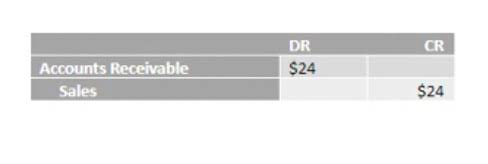
If a company keeps accurate records using the double-entry system, the accounting equation will always be “in balance,” meaning the left side of the equation will be equal to the right side. The balance is maintained because every business transaction affects at least two of a company’s accounts. For example, when a company borrows money from a bank, the company’s assets will increase and its liabilities will increase by the same amount.
D. Assets = Liabilities + Retained Earnings − Dividends
- All such information is provided solely for convenience purposes only and all users thereof should be guided accordingly.
- The global adherence to the double-entry accounting system makes the account-keeping and -tallying processes more standardized and foolproof.
- The accounting equation is a core principle in the double-entry bookkeeping system, wherein each transaction must affect at a bare minimum two of the three accounts, i.e. a debit and credit entry.
- This equation should be supported by the information on a company’s balance sheet.
Net income is the entire amount of residual income that remains after all cash flows—positive and negative—have been taken into account. Net income may provide information about a company’s profitability. When Taylor receives the loan in cash, it does not affect the money supply because cash is already part of the money supply.
B. Practical examples to illustrate calculations
Along with Equity, they make up the other side of the Accounting Equation. So, if you really understand this equation, the rest of accounting becomes that much easier. Working capital indicates whether a company will have the amount of money needed to pay its bills and other obligations when due. Not all companies will pay dividends, repurchase shares, or have accumulated other comprehensive income or loss. Drawings are amounts taken out of the business by the business owner. Shaun Conrad is a Certified Public Accountant and CPA exam expert with a passion for teaching.
- This transaction affects both sides of the accounting equation; both the left and right sides of the equation increase by +$250.
- Equity is named Owner’s Equity, Shareholders’ Equity, or Stockholders’ Equity on the balance sheet.
- Put another way, it is the amount that would remain if the company liquidated all of its assets and paid off all of its debts.
- Most sole proprietors aren’t going to know the knowledge or understanding of how to break down the equity sections (OC, OD, R, and E) like this unless they have a finance background.
- The equation states that the total assets of a business must equal the total liabilities plus the owners equity in the business.
- The accounting equation is so fundamental to accounting that it’s often the first concept taught in entry-level courses.
What Is the Purpose of the Double-Entry System?

Revenue and operational expenses are used to determine the operating profit formula, which is essential for assessing the financial standing and performance of organizations. The accounting equation uses total assets, total liabilities, and total equity in the calculation. This formula differs from working capital, based on current assets and current liabilities. It’s a tool used by company leaders, investors, and analysts that better helps them understand the business’s financial health in terms of its assets versus liabilities and equity. If the left side of the accounting equation (total assets) increases or decreases, the right side (liabilities and equity) also changes in the same direction to balance the equation. Under the accrual basis of accounting, expenses are matched with revenues on the income statement when the expenses expire or title has transferred to the buyer, rather than at the time when expenses are paid.

Analyze a company’s financial records as an analyst on a technology team in this free job simulation. Our popular accounting course is designed for those with no accounting background or those seeking a refresher.

- The balance sheet is a reflection of the basic accounting equation.
- Additionally, analysts can see how revenue and expenses change over time, and the effect of those changes on a business’s assets and liabilities.
- The accounting equation relies on a double-entry accounting system.
- An accounting indicator known as ‘operating profits’ is used to express a company’s earnings from its primary business operations after taxes and interest have been subtracted.
- For this reason, it only provides a rough estimate, not a precise prediction.
- This is because the funds held in checking accounts are still part of the money supply, just in a different form.
The owner’s equity is the balancing amount in the accounting equation. So whatever the worth of assets and liabilities of a business are, the owners’ equity will always be the remaining amount (total assets MINUS total liabilities) that keeps the accounting equation in balance. The accounting equation states that total assets is equal to total liabilities plus capital. This lesson presented the basic accounting equation and how it stays equal. The income statement is the financial statement that reports a company’s revenues and expenses and the resulting net income.

These organizations can operate without undergoing a separate approval process on the state level, as their federal tax-exempt recognition is generally acknowledged by California. However, it is important to note that even though they are granted automatic tax-exempt status, they are still required to comply with certain regulations and file certain documents with the state. Overall, this automatic tax-exempt status is meant to streamline the process for organizations that meet certain criteria. Please note that this calculation assumes a simplified scenario and doesn’t consider transaction costs or other factors that may affect the final outcome.

C. Real-world examples for better understanding
A beta of less than 1 indicates that the stock is less volatile than the market, while a beta greater than 1 suggests that the stock is more volatile. To calculate the required beta of stock C, we need to consider the desired portfolio beta and the betas of the other two what is the formula for the basic accounting equation? stocks. In the state of California, certain organizations would be granted an automatic tax-exempt status without having to apply and go through the approval process on the state level. These organizations include churches, schools, and certain charitable organizations.
In contrast, a firm that has a poor operating profit may decide to alter its tactics, make cost reductions, or boost productivity. To calculate your net profit or loss from purchasing a put option, you need to consider the premium paid for the option and the stock’s current market price. The relationship between the stock price and the strike price determines the call option’s payoff. The payoff is positive if the stock price exceeds the strike price.
